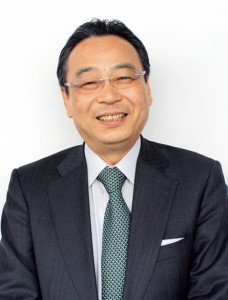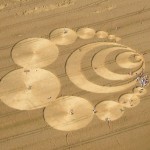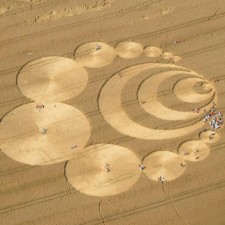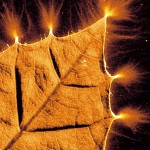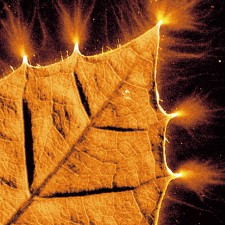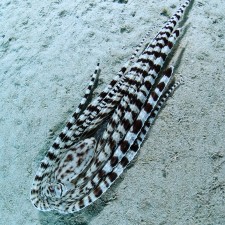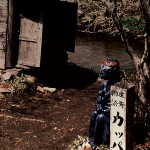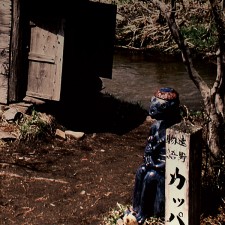Scientific Logic and Narrative Logic
Humans, animals, even plants, continually express themselves. Ceasing to express yourself is practically the same as being dead. Although the life mechanisms are all different, the fact that everything works on the scale of the earth is because all the expressions adjust to each other.
In plants, trees of different species communicate with each other to shape the forest. This doesn’t function very well in planted forests, but in natural forests groups are formed that may break apart and reconnect but still persist. Before, I used to think about this sort of persistence and connections in my head, but actually going out into the forest and trying to express myself made everything much clearer. It is also related to how to create a world that doesn’t separate between subjectivity and objectivity. Same thing with the division between science and religion. Whenever someone tries to fuse the two, you hear talk about “great cycles of life” and such, but more concretely, the important point is to create an expression together. Co-creation is when people from different backgrounds come together to form a joint expression. Elucidating the profound parts of the connections is inseparable from answering the question of the function of life itself. One the one hand, we have scientific logic, and on the other, we have the narrative logic that makes up the drama of our everyday lives. Currently, the two are completely separate.
The Mismatch Between Doing and Being
In fields such as rehabilitation it is common to see that the communication between the helping side and those receiving help doesn’t work very well. For the helpers, the goal is simply increased functionality. Most helpees, however, know that they will never recover. But they want to recover. Sooner or later they have to notice that they won’t be able to return to their old lives and instead need to think about how to live their lives from now on. Becoming aware of this is something that really needs support, or communication will break down. One side is thinking about the problem of how to live, and the other about what to do. If doing and being don’t match, errors will occur. Only after sharing how you want to live can you discuss what should be done right now. A two-level communication is necessary.
Our current smartphones and IT communication tools are totally focused on “what to do.” That is why only functional systems can be built. At the same time, the desire to express themselves is dropping among most children today. In fact it is dropping among adults too, as communication using symbols alone is becoming the norm. Messages that may contain subtle nuances are received at face value, since the meaning of the interpretation is not shared.
Column 1
Plant CommunicationIn plants, every species has a prototypical biological potential waveform. Camellias have a common camellia pattern, as it were, and oaks have an oak pattern. However, in the mountains those waveforms disappear, new groups are formed and new common patterns are created. In a natural forest, groups are formed with around 20 – 30 trees of several species, and the members sometimes change with the seasons. In planted forests with only a single species, on the other hand, there is basically only a single biological potential waveform as well. Planted forests also require periodical thinning. That is to say, they are based on a central competitive principle where some trees are removed, and it is the trees whose waveforms differ from the uniform waveform that are eliminated. Thinning pros are unconsciously aware of this, and generally the trees that are cut down show an abnormal biological potential.
Inclusive Design and Inclusive Dance
“Inclusive design” is a new idea that follows “universal design.” “Awareness design,” you might also call it. Universal design is based on gathering the opinions of the elderly and disabled, and leveling them. In inclusive design, the elderly and disabled themselves are present in the design process, to the very last step. It is they who make the developers aware.
“Inclusive” means that everybody can be part of the creation on an equal footing, disabled or not, and regardless of age. It could be a commercial product, or a performance or a work of art. The people who participate form connections.
Professor Yoko Nishi of Toyo Eiwa University has invented something called “inclusive dance.” For example, two people who put the palms of their hands together and spontaneously move their bodies form a connection. A group of students, who went to see children in wheelchairs dance, found it difficult to join in, even they were invited to do so. They didn’t know if it was OK to touch, or to press, and so they hesitated. But once the students had joined in, their individuality was soon drawn out of them.
Inclusive dance is improvised, so there are no rules. On that base, a little bit of the future is shared, because the field is also shared. The movements of the field are not an extension of the past, but a concurrent expression of the present that is shared a bit into the future. That is, it leads to a simultaneity, synthesis and equivalence of expressions. As far as expressions are concerned, healthy people and disabled people are equal.
It is a condition like being enwrapped within one giant body. Nishi refers to it as “wrapping while wrapped, wrapped while wrapping.” If it gets completely unified it shuts down, so it sometimes breaks apart, sometimes comes back together.
From “By Oneself” to “By Itself”
We are currently investigating the dynamics of the phenomenon that when people put their palms together and create an expression, their feelings are shared. If that is possible, it should also be possible to create links over longer distances. Palm to palm communication, as it were. Generally, when you put your palms together and move your body, almost every part of the body moves at once.
When you have an image in mind, however, some parts of the body move before the others. Before you consciously move your hand, it has already moved unconsciously. The time lag is about 0.3 seconds. When two people put their palms together, the timing of their unconscious advance movements match.
You think you are moving your hand “by yourself,” but it moves “by itself.” The field resonates to create an expression. Curiously, 1/f fluctuations emerge at that time.
The region where the conscious and the unconscious turn into each other is extremely important. That border region is where the field arises. It resonates and connects to the other. The expression keeps moving forward, towards the future, so that the region changes all the time.
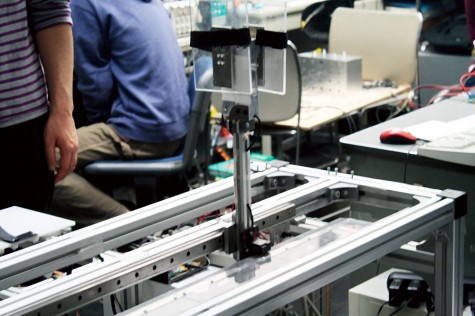
Investigating the dynamics of people putting their palms together.
The Future of Margins and Media
Current media, and digital technology in particular, can only handle what is visible. There is nothing behind a CG image, for example. With the systems we have now, you have to provide the system with boundary conditions in order to proceed with the design.
Objectively speaking, those boundary conditions do not really exist, but in science and engineering you have to establish them anyway to get anything done. What is outside is ignored, and what is inside is the stuff to be designed. Nobody does design where the outside is allowed to cross over inside the boundary. Expression is continuously making your own boundaries. Creating your own boundaries and constraints is one of the fundamental activities of life. Our current media could be called “nominal.” Nouns refer to the pre-existing world of “things.”
There ought to be “action”-like media too where nouns move in from the verbal side, I think. Probably many ideas in Japanese culture, like rock gardens and haiku, Shinto shrines and Noh theatre, were created like that. You make a blank space and let the subject appear. Blank spaces or margins are not bits that have been left unwritten, but spaces where something can be born. A part that is left behind in contact with nature, open-ended. Not disconnected from nature, or the world of the dead. A present that contains both the dead and nature and those now living.
The notion that “things exist for us to own them,” that is to say, modern Western civilization’s ownership-driven method of expansion, is becoming invalid. Even the West is slowly starting to realize that we need to switch to “keeping things so that they exist.” In addition to the idea of engineering for industry, there could also be engineering for culture and engineering for society, I think. A move from technology for features to technology for existence is also in order. In particular after the earthquake disaster, Japan has the potential to show the way. Technology that circulates between existence and functions would perhaps be ideal, but so far, the principles of science appear to have been too harshly applied to humans, and the rules about what humans should be like have been far too restrictive.
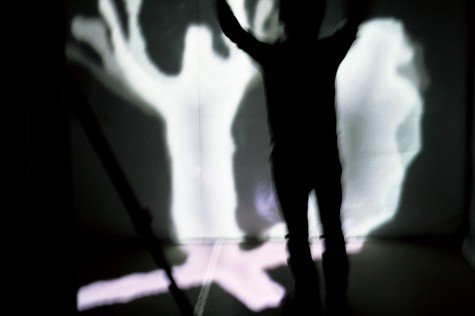
A shadow-based communication system
Column 2
Shadow MediaMiwa’s laboratory has developed a communication system using shadows. When you enter the screening room, your shadow, as transformed by a computer into different volumes and shapes, is projected on the walls and floor. As your shadow touches those of other people and the shadows merge with each other, a strange sense of unity is born, without the use of words. It is a bit like the old game of “stepping onto shadows.”
Shadows are different from mirror images in that they are connected to the body and may be incomplete, and since they involve a certain kind of blank space, they function as triggers to draw out images from inside the body.





